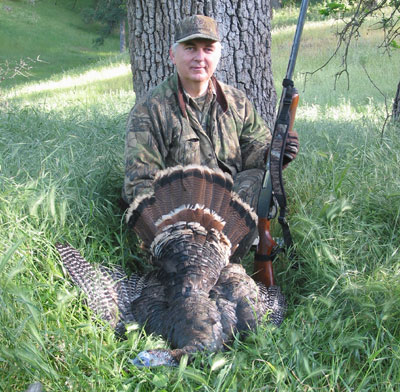

My back was against the six-inch trunk of a young oak tree on a ridgetop in Calaveras County, California. I had just given a couple of yelps from my new Quaker Boy Hurricane box call. It was still early morning, but more than 30 minutes since the beginning of legal shooting time and I had just settled into my ambush location.
I was observing how dry it was for the end of the spring turkey season. The rain, which had been so plentiful those first few days of March, had just stopped like the turning off of a faucet. Now it was the beginning of May and instead of sitting in green grass as tall as my bent knee, the seat pad of my turkey vest was on dry, hard ground, smashing the already partially brown, short grass. But it was the Thursday before the close of the season and it was still a beautiful place to be on that sunny morning.
I picked up my call and gave the paddle a couple of hard, fast moves on the box to give out loud yelps. I then quickly strained my left ear hoping to hear the familiar gobble that I have heard so many times in the past. There it was — very faint, but it was a gobble for sure. Oh, boy, my heart started pounding faster.
I was guessing that the turkey was well over 500 yards away, across a very large field and into the woods on the far side of the property on which I was hunting. A knoll to my left and the lay of the land made it impossible to see more than 80 yards in the direction from which the gobble had come.
I turned my body in the direction of the field and made another set of calls. Yep, he was interested — the gobble came back a little louder. Even though he was far away, I needed to make some quick decisions... Should I put out my decoy? If I didn't, he was going to be on top of me before I saw him and it would be better to have him looking at the decoy rather than looking at me. Should I set up in a better position? OK, I quickly stood up and started moving down the fence line that separated me from the field — oh, did I mention that the other side of the fence, where the turkey was, of course, wasn't property I could hunt? I continued down the fence line but found I just increased the angle of the knoll on the other side of the fence so that gobbler was really going to be on top of me by the time I could see him. I moved down a little farther and pulled out my decoy. I placed it on a low pile of brush so it was visible above the grass. I moved back up the fence line and found a tree to lean against.
The gobbles were now louder and closer. A little more calling and I could tell he was just over the knoll. But what had I done to myself... I was so close to the fence and hadn't thought about how the turkey was going to get to my decoy. That's right, the fence was now a barrier because it was of hog wire. Too late to worry about it now. I had to leave my box call on the ground and have my shotgun up to my shoulder because he could pop into sight at any second. Suddenly there was movement in the tall grass on the knoll. It was running movement, but was it the gobbler? I hardly could form the question in my mind before the gobbler changed its run into flight, clearing both the fence and my decoy.
It was a fatal mistake for him. For only minutes later I was on the walkie-talkie to my wife, Diane, who had been waiting for me down the ridge in the pickup.
"Did you get one", she said. "Yes, a nice jake with a 5-inch beard" I replied.
It had taken about 45 minutes to call in that gobbler and not long after that my wife and I were sitting down for breakfast in a restaurant in Angels Camp. Mixed in with the pancakes and coffee was a good serving of my detailed story of my long-distance turkey hunt.
What a terrific way to spend a morning!
Copyright © 2004 J & D Outdoor Communications. All rights reserved.